I have always been fascinated by Vuylstekeara Cambria. It w as the first Odont that I ever got from Keith Andrew, the original mother plant no less and I registered my first hybrid from it in 1984, the year before I left Santa Barbara to move back to New Zealand. Keith had brought a piece of the parent plant to me on one of his visits to Eugene, OR in the mid-1970’s and I had become very interested in Odont breeding once we moved to Santa Barbara in 1978. My first Cambria hybrid was with the lovely Mansell & Hatcher hybrid, Oda. Red Rum and I named it for my mother. They were pretty and very free blooming but none made the cut in judging.
as the first Odont that I ever got from Keith Andrew, the original mother plant no less and I registered my first hybrid from it in 1984, the year before I left Santa Barbara to move back to New Zealand. Keith had brought a piece of the parent plant to me on one of his visits to Eugene, OR in the mid-1970’s and I had become very interested in Odont breeding once we moved to Santa Barbara in 1978. My first Cambria hybrid was with the lovely Mansell & Hatcher hybrid, Oda. Red Rum and I named it for my mother. They were pretty and very free blooming but none made the cut in judging.
When I was living in New Zealand, I made two crosses onto my Vuyls. Cambria ‘Plush’. The first was a crossing to Vuyls. Mem. Mary Kavanaugh 4n, which had been made with two tetraploid parents. Even then I was looking for a warmth-tolerant Odont but when the cross bloomed out at Floricultura, all the stems were a couple of flowers short of being long enough to be commercially viable. That didn’t stop a certain Hawaiian taking one of the plants asserting he would use it for hybridizin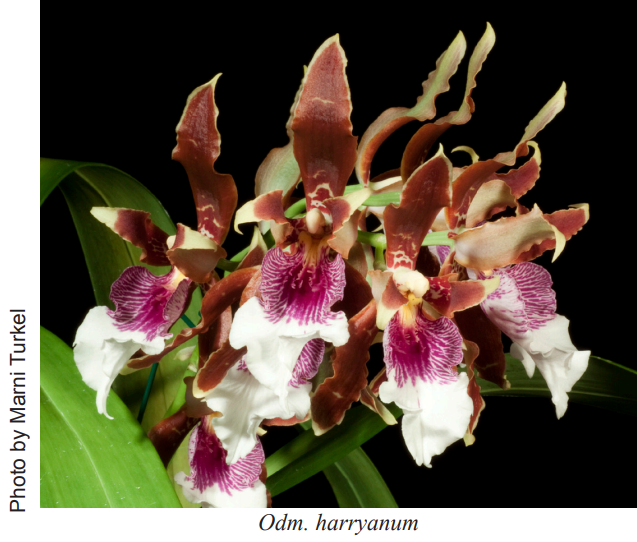 g. Of course he cloned it and that did not go over well with either Floricultura or me. But all water under the bridge now, a failed line. The other crossing I made was back to Odm. harryanum, a typical form that I had brought from the US. We sold some of the flasks into Australia and in 2002, one was awarded HCC/AOS for Atlantis Orchids with the name of Vuyls. Wyatt’s Torch. Now that might have been an unfortunate grex name but let the story unfold. I was back in the US from July 2000 onwards and when I finally caught up with the photo, I was horrified. Firstly, the flower looked nothing like I expected (this has happened to me many times!!) but also I seriously doubted the recorded parentage and felt like I had made a serious labeling error.
g. Of course he cloned it and that did not go over well with either Floricultura or me. But all water under the bridge now, a failed line. The other crossing I made was back to Odm. harryanum, a typical form that I had brought from the US. We sold some of the flasks into Australia and in 2002, one was awarded HCC/AOS for Atlantis Orchids with the name of Vuyls. Wyatt’s Torch. Now that might have been an unfortunate grex name but let the story unfold. I was back in the US from July 2000 onwards and when I finally caught up with the photo, I was horrified. Firstly, the flower looked nothing like I expected (this has happened to me many times!!) but also I seriously doubted the recorded parentage and felt like I had made a serious labeling error.
Now I am living in the US and travelling down to Colombia for orchid events and affairs of the heart! In the late 2000’s, I was foolishly given the freedom to make some Odont crosses at Colomborquideas and I was intrigued to use one of the very first Vuyls. Cambria ‘Plush’ meristems from Vacherot & Lecoufle as a pod parent for the crossing with Odm. wyattianum. I lost track of this effort and suddenly, when I flew down to the Medellin Orchid Festival in 2016, I saw the first seedling of this cross in bloom. Of course I did not judge it but another team did and gave the plant an AM/AOS. When the cross was registered, it was named Vuyls. Andy’s Idea.
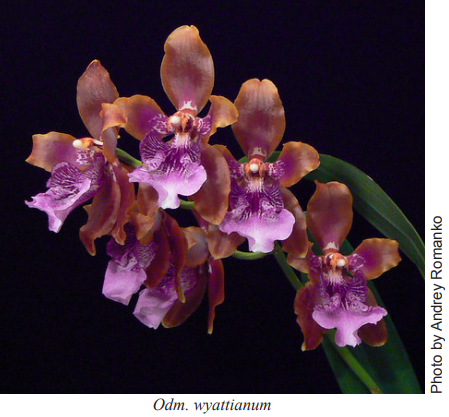
Let’s go back in time and have a close look at Vuyls. Cambria. It is a most interesting orchid indeed. The pollen parent was Odm. Clonius, a Charlesworth plant which had lost its label so apart from seeing anunknown lineage, nobody can be sure even what the plant was clearly its star offspring. Because it was never shown/awarded, there are no RHS paintings or photos to cast any light on this mystery plant. The pod parent however was no mystery but no “fertile Myrtle” either! Vuyls. Rudra gave rise only to Vuyls. Cambria and although it was well bred, the whole line was distinguished by infertility. It is also confusing as the name Brewii appears twice in the Vuyls. Rudra background, as the immediate parent, Vuyls. Brewii and also as the grandparent, Oda. Brewii (Odm. harryanum × Oda. Charlesworthii). Vuyls. Brewii became a Vuyls. by the addition of Mps. vexillaria, the only Mps. influence looked like. It really only featured in Charlesworth breeding and apart from an Odtna. Amphea which in some respects resembled Cambria, Cambria whatsoever in Cambria! The other grandparent is Odm. Prince Edward (Odm. Crispo-harryanum × Odm. Rolfeae) and while one might have expected it to have contributed much to Odont breeding, it managed only three obscure registrations.
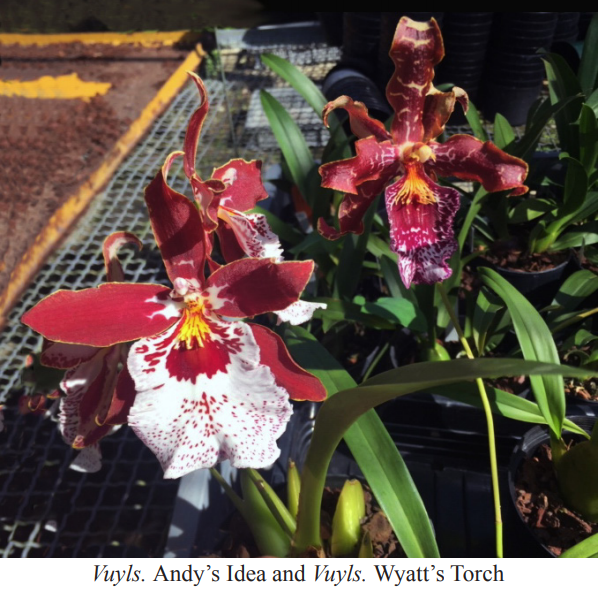

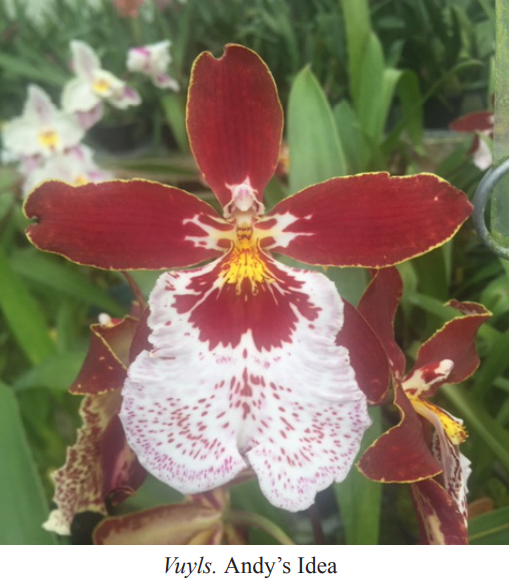
 So where is this article heading. A year or two after I made Vuyls. Andy’s Idea, I decided to remake Vuyls. Wyatt’s Torch. The plants came into bloom and about six weeks ago, I noticed two small pots in bloom in adjoining trays. One was a straggler from the Andy’s Idea crossing and the other was a front-runner from the Wyatt’s Torch. I stopped, looked and then the penny dropped..... with a resounding clang. You can see the picture I took and I could scarcely contain myself when I realized the implications of what I was observing. From this point onwards, this article is presenting my ideas, my explanation for what I believe has happened in Odont breeding and I’m quite sure will stimulate argument and disagreement. But here we go.....
So where is this article heading. A year or two after I made Vuyls. Andy’s Idea, I decided to remake Vuyls. Wyatt’s Torch. The plants came into bloom and about six weeks ago, I noticed two small pots in bloom in adjoining trays. One was a straggler from the Andy’s Idea crossing and the other was a front-runner from the Wyatt’s Torch. I stopped, looked and then the penny dropped..... with a resounding clang. You can see the picture I took and I could scarcely contain myself when I realized the implications of what I was observing. From this point onwards, this article is presenting my ideas, my explanation for what I believe has happened in Odont breeding and I’m quite sure will stimulate argument and disagreement. But here we go.....
I do not and never will believe that Odm. wyattianum only reached England in the late 1920’s. I have two reasons for saying this. Taxonomists used to say that Odm. harryanum is only found in an isolated area of Colombia but just this month I saw collected plants from Ecuador with an enthusiast in Bogota that were quite clearly Odm. harryanum! Taxonomists also say that Odm. wyattianum comes from Peru but I believe there is a continuum where Odm. harryanum changes morphologically in Ecuador and that at some point it certainly has made a natural hybrid with Odm. wyattianum and that natural hybrid, which has speciated, is the orchid currently known as Odm. deburghgraeveanum! My goodness..... will I be called before the taxonomic council and beaten to within an inch of my life? Doubt it! But I’m not finished yet.
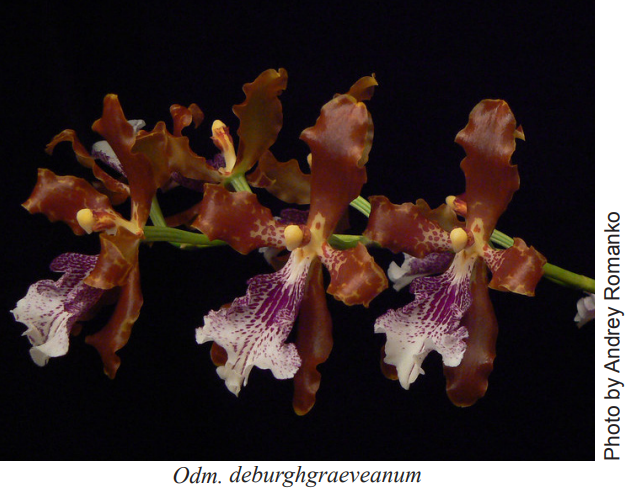
My view is that Odm. harryanum and Odm. wyattianum were collected and growing in English and continental orchid collections together well before the turn of the 20th Century! It would be interesting to actually see some of the old RHS paintings of socalled Odm. harryanum awards. But that is not even necessary. Why? Because as recently as the 1970’s. Odm. harryanum ‘Copper’ gained an AM/RHS for Burnham Nurseries and it is clearly a typical Odm. wyattianum! The RHS Orchid Committee making a mistake, dear God please tell me that’s not so!
Can I maybe call on the Sander name to vindicate at least partially, my viewpoint? In Sander’s Orchid Guide, 1927 Edition there are the comments about Odm. wyattianum and a comparison to Odm harryanum. It says that Rolfe and Reichenbach authenticated several distinct varieties of Odm. harryanum in the 1880’s. Then it goes on to state of Odm. wyattianum that “the nearest affinity of this species seems to be Odm. harryanum”. It comments that Odm. wyattianum is “5 or more flowered” and adds that Odm. wyattianum has “not yet been authoritatively identified”.
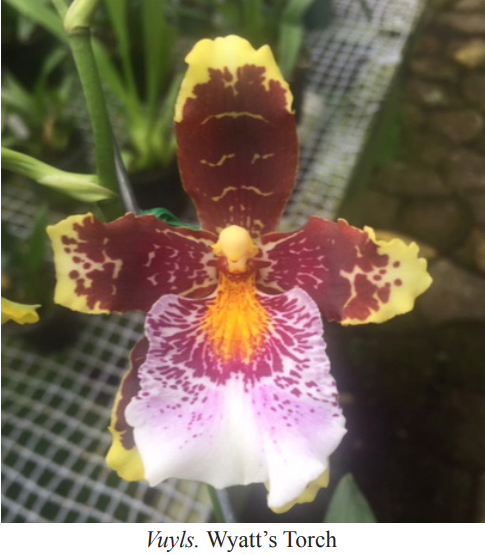
So lets look at the photo which made the scales fall from my eyes! Vuyls. Andy’s Idea looks to all intents like a typical Vuyls. Cambria. Better even than some of the Cambria mutations we saw in recent times. Big flat lip.... from the Odm. wyattianum with just a little influence from Mps. vexillaria. I will also show you the picture of the awarded one, Vuyls. Andy’s Idea ‘Ligia Posada’. Apart from a slightly duller color intensity, you could be looking at Vuyls. Cambria ‘Plush’. And as the crossing is diploid with diploid, I have the plant holding three fat pods awaiting a trip to the Lab at the end of this year. Compare that with Vuyls. Wyatt’s Torch, nothing like Cambria. More rolled lip as one would expect in a hybrid from Odm. harryanum. The Wyatt’s Torch pictured in OrchidWiz matches the picture here and dare I say it, is a superior and rather more harryanum-influenced phenotype.
OK, this is my opinion and I believe that opinion is backed up by the evidence I have presented. You are welcome to argue or disagree but I’m very confident this poorly trained botanist may be onto something! Far from stopping the use of Vuyls. Cambria in hybridizing, we have added a tetraploid version and at present would have at least 20 crosses that we will soon be registering via the International Odontoglossum Alliance Journal. Vuyls. Cambria ‘Plush’ may be from the 1930’s but I’m fairly sure we will see its progeny well into the 2030’s! Not bad going for an old-timer.
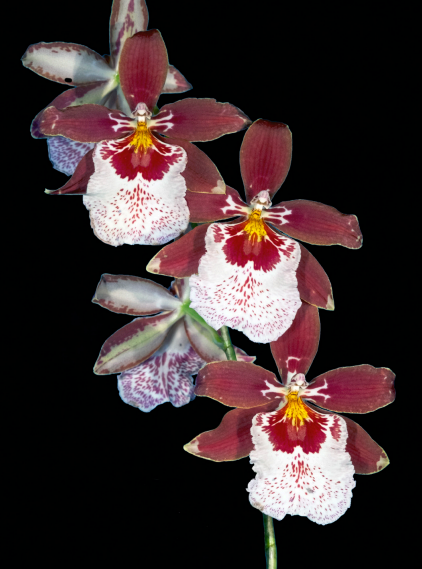 Vuyls. Andy’s Idea.
Photography credit: Andy Easton
Vuyls. Andy’s Idea.
Photography credit: Andy Easton